[Continued from Part 1 of this article.]
Millions of visitors poured into Chicago during the 1893 World’s Fair. They arrived by train, boat, carriage, wagon, horseback, bicycle, and several even walked. A few others chose, well … less conventional modes of transport. For example, Herman Zeitung—the Austrian tailor, small in stature but big in bravery—mailed himself C.O.D. to the 1893 World’s Columbian Exposition. When he popped out of his cargo box on July 28, officials must have thought “Oh, no. Not again!”
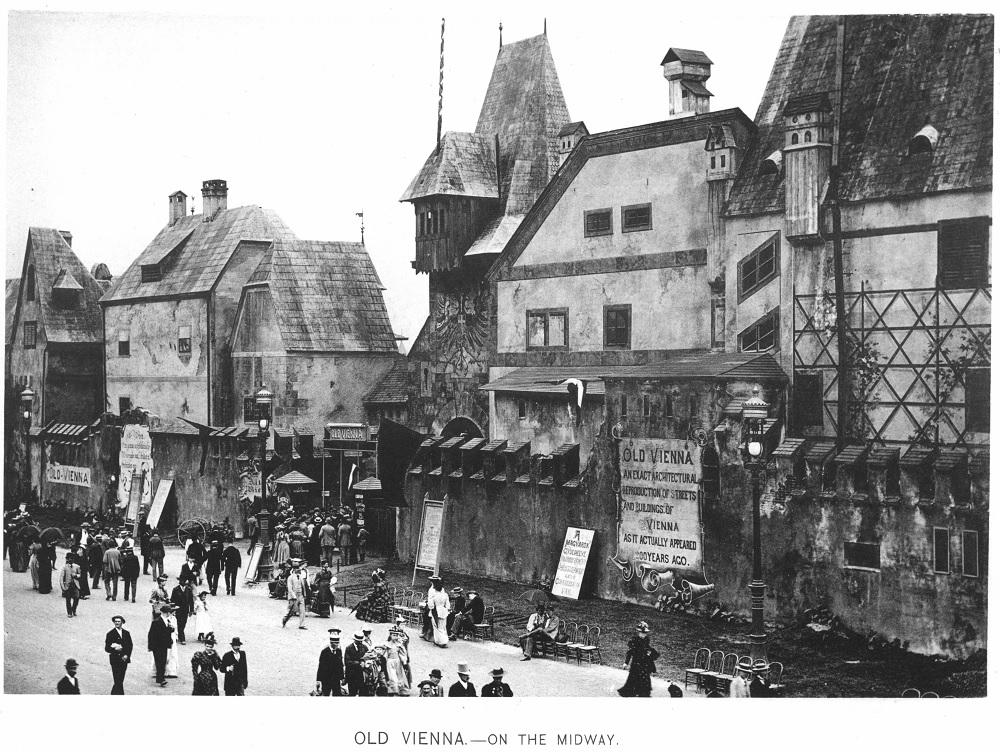
The front gate of the Austrian Village, also called “Old Vienna,” on the west end of the Midway Plaisance at the 1893 World’s Fair. [Image from Arnold, C. D.; Higinbotham, H. D. Official Views of the World’s Columbian Exposition. Press Chicago Photo-gravure Co., 1893.]
“I greet you all!”
Mr. Zeitung was the second Austrian man to land on the Midway Plaisance packed inside a shipping box from New York that week. The first had beaten him to the World’s Fair by just four days, arriving in the Austrian Village. On the afternoon of Monday, July 24, a young blond-haired man wearing a knit undershirt, knickerbockers, and stockings emerged from his wooden box frantically waving the Austrian flag in his left hand and the Stars and Stripes in his right. “I greet you all,” he shouted. “I’m an old Viennese boy myself, and hurrah for ‘Old Vienna’!” His name was Ignatz Lefkovitz.*
* Various newspapers spelled his last name as either “Lefkovite,” “Lefkovitc,” “Lefkovetz,” “Lefkavitz,” or “Lefkovitz.” Either the latter or his first name are used in this article.
“The Exposition people are getting a little tired of receiving miscellaneous human freight,” wrote the Chicago Tribune after the second crate, containing Mr. Zeitung, showed up four days later. Officials reportedly threatened to fumigate with sulfur all express packages arriving on the fairgrounds before opening them. These human-cargo shipping stunts also put delivery companies on alert. If such railway swindlers could successfully sneak themselves into the fairgrounds, couldn’t thieves use the same trick to access the goods transported by train? If he was not a thief, then why had Ignatz come to the Fair?
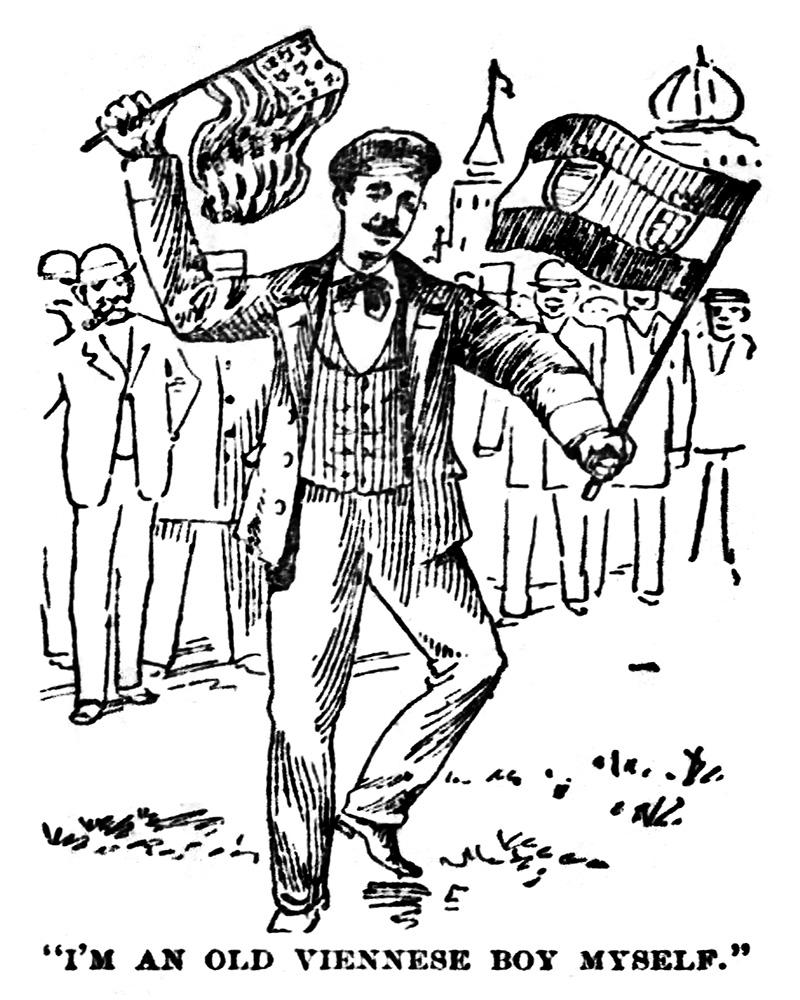
I’m an old Viennese boy myself,” shouted Ignatz Lefkovitz as he jumped out of his box. [Image from the Leavenworth (TX) Standard Aug. 15, 1893.]
Ignatz hatches his plan
Ignatz Lefkovitz was born in Vienna and lived in Venezuela before coming to America in October 1892. The twenty-four-year-old was living in the Lower East Side of New York in the summer of 1893. Some reports state that he was unemployed, while others describe him as the “maker of transparent pictures” and working with a Mr. Oppenheimer a few blocks from his apartment. In New York on Thursday, July 20, 1893, Ignatz met Mr. Marcus Braun, a fellow Wiener and the Press Agent for the Austrian Village on the Midway Plaisance. This gave him an idea, though he did not share it with Mr. Braun.
Seeking fame and money, Ignatz Lefkovitz devised a scheme to ship himself to the World’s Fair in Chicago. His inspiration came from a news story about a little tailor from his native Vienna who, years earlier, had traveled inside a cargo box to Paris and made some money from the publicity. That man, Herman Zeitung, just happened to be in New York at this time, making his arrangements to be shipped to the Chicago fair in a box.
Borrowing $15 from Mr. Braun and some friends, Ignatz began to assemble materials for his clandestine trip. For $1, he purchased a wooden dry-goods box that was six feet long, four feet wide, and three-and-a-half feet deep. In the cover was a cunningly devised trap door that could only be opened from the inside and through which air could be brought in. For added comfort, the young man outfitted the bottom with a bit of carpet and lined the sides with straw. He hung some festive bunting representing the Austrian and American colors, along with pictures of Austrian Emperor Franz Joseph and U.S. President Grover Cleveland.
Using the remaining money, he stocked the shipping container with quite an assortment of provisions for the long train ride: five lemons, some sugar, nine hard-boiled eggs, a string of frankfurters, a loaf of rye bread, several bottles of lemonade and ginger ale, bottle of cognac and rum (which, he insisted, went untouched), a bottle of coffee, a bottle of vinegar, a twenty-five-pound chunk of ice wrapped in a blanket, a thermometer, the aforementioned national flags, and a pillow.
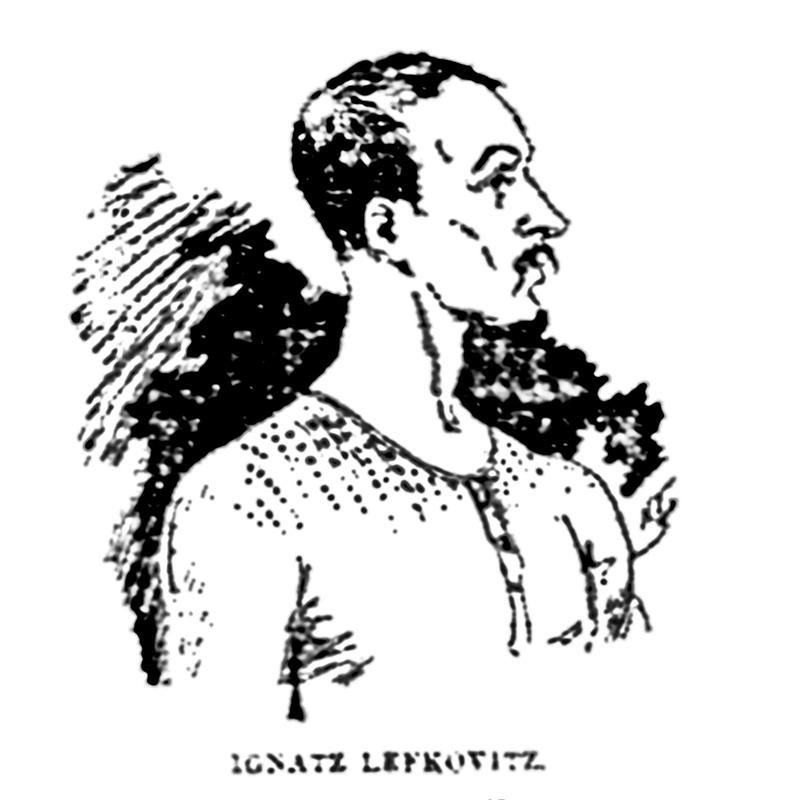
A portrait of Ignatz Lefkovitz upon his arrival at the 1893 World’s Fair in Chicago. [Image from the Chicago Herald July 25, 1893.]
A package of glass
At 6:30 pm on Saturday, July 22, Ignatz climbed into the box and bid farewell to his friends, who nailed the container shut and pasted a label on its lid:
“GLASS! THIS SIDE UP! WITH CARE!
TO OLD VIENNA, JACKSON PARK,
CHICAGO, ILL.”
His friends delivered the purported “package of glass” intended for the Old Vienna restaurant to the American Express agent at Grand Central Depot. The train for Chicago departed at 8 pm. That same day in Colorado, Katharine Lee Bates wrote her poem “America the Beautiful,” containing a reference to the beautiful White City she had seen while passing though Chicago. Ignatz would have to survive forty-one hours in a box before seeing the alabaster city gleam in Jackson Park.
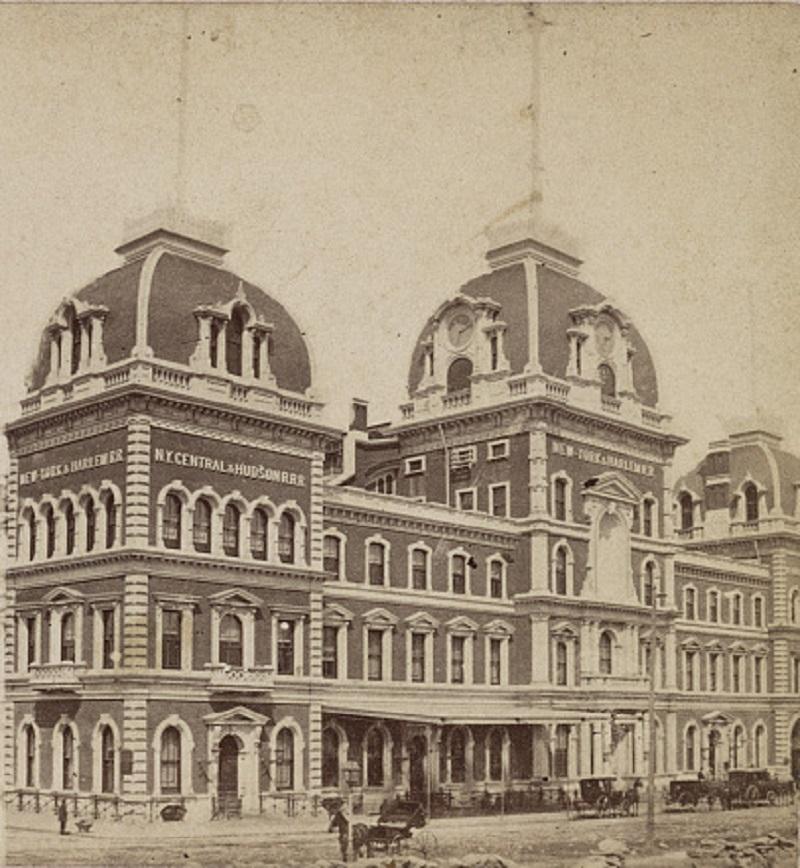
Grand Central Depot in New York, [Image cropped from C. W. Woodward stereoview card, Library of Congress.]
Keep it right side up
Ignatz was only able to fit in the box with any degree of comfort by laying his side or back with his legs doubled up. “My limbs became cramped,” he later admitted. “When I wanted to stretch my legs, I had to bundle my body up in a ball, and that was not comfortable.”
He reportedly spent some of the nearly 1000-mile train ride on his head. “The top of the box bore instructions to keep it right side up,” Ignatz said, “but they did not pay much attention to that and rolled me around like a block of wood.”
There were bigger discomforts. His cargo container had been tossed into a train car with cases of eggs piled on top, and some of them did not survive the journey to Chicago. But the odor and occasional splattering from above were nothing compared to the stifling heat. Because of the tight packing of crates around him, Ignatz could not open his trap door to let air in. “I did not suffer very much,” the young man reported, “although it was very warm. At times I thought I should smother.”
At one point on the journey, a sliver of light coming through a crack in the box allowed Ignatz to see his thermometer: It read 106 degrees Fahrenheit! He related the experience to a Tribune reporter:
“Say, but I was thirsty. I was not hungry, in fact did not eat a single thing, but if I had had four times as much to drink I should have got away with it. Still, I didn’t want the rum, but the acids of the lemonade and vinegar seemed just what I needed. I slept a good deal that first night and dozed considerably during the day. I changed cars once, it must have been at Buffalo, but the men handled the box carefully and I wasn’t hurt.

Fun fact! Most visitors travelling to the 1893 World’s Columbian Exposition in Chicago by rail did so sitting in a passenger car rather than riding in a cargo box. [Image from Scientific American Oct. 14, 1893.]
“I simply thought I should die”
Despite the cramped confinement, dripping eggs, and stifling heat, Ignatz claimed that he had suffered no particular inconvenience until reaching Chicago at 5 am on Monday. He had arrived on what would be one of the hottest days of the summer at the Fair. Ten minutes after the train stopped, his box received a good shaking while being unloaded. Ignatz found himself standing on his head only to be thrown onto his back a moment later, and after several more revolutions tossed upside down again. This left him stuck on his head for over an hour. He sustained a few bruises.
Things got worse when an attendant moved the box into the sunshine. “Hot? Well, I simply thought I should die,” he said.
“That thermometer of mine registered 156° for over half an hour, and if two men had not come along and thrown me on top of a pile of boxes, I think another half hour would have certainly killed me. Then I was thrown into a wagon, bumped over the streets for four or five hours, it seemed to me, and finally landed in Old Vienna. I heard the man kicking when the expressman told him the charges were $12.40 and knowing that in a few minutes I was to be free, I gathered what little strength I had left to make a proper appearance or exit, whichever you call it.”
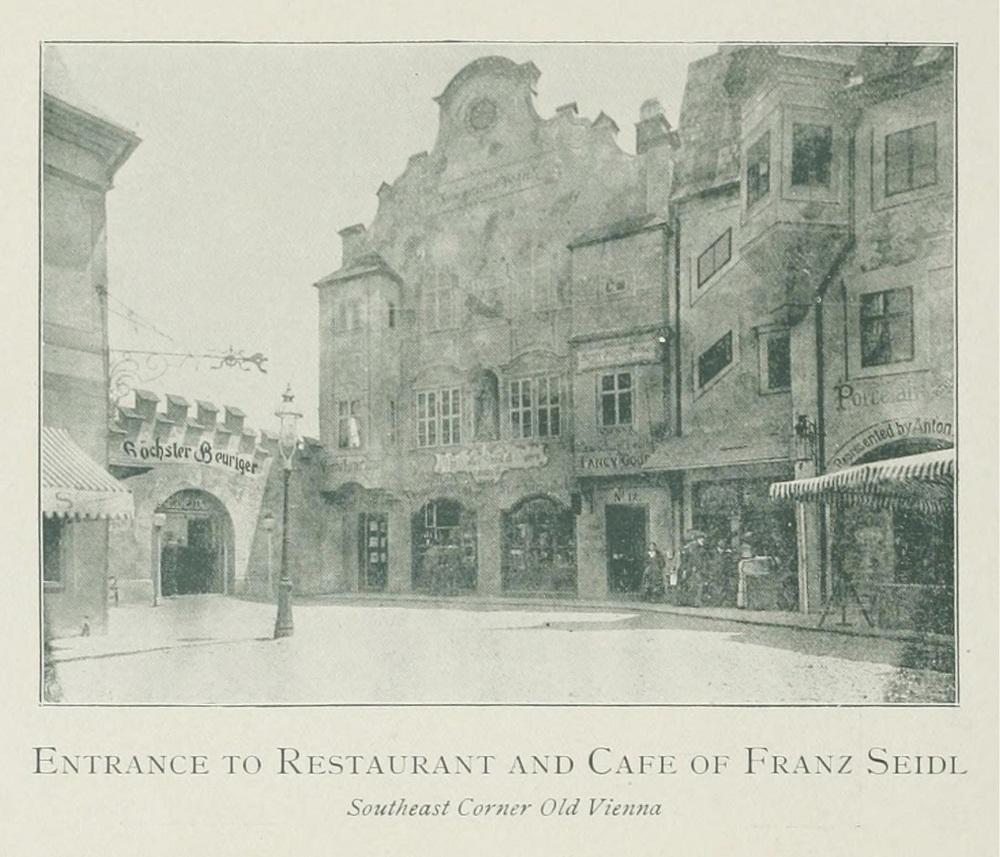
Franz Seidel’s Restaurant and Café, where Ignatz Lefkovitz rested after his arrival. [Image from Smith, Frank H. Art History Midway Plaisance and World’s Columbian Exposition. Foster Press, 1893.]
Hacked with a hamburger ax
The commotion in the Austrian Village began around 2:30 that afternoon. The Royal Austrian Commissioner Chevalier Etienne von Scanavi was enjoying lunch with Manager Arnold Weissberger in Old Vienna when an excited messenger boy interrupted with news that an express package had arrived. Waiter, shopkeepers, and barmaids gathered around the large box left inside the front gate. The American Express delivery man collected his charge of $11.40 but then was frightened by the sound of rapping coming from inside the box. A hamburger cook in the village used his meat ax to pry some boards off the box. “Read the sign,” the contents implored, referring to the label’s instructions to handle with care. The shocked crowd watched as a thin young man popped up like a Jack-in-the-box. He attempted to leap boldly out of the container, but instead stumbled from exhaustion and would have fallen into a heap had someone not caught him.
Marcus Braun, Press Agent for the Austrian Village, recognized the young man whom he had met in New York the previous week. Mr. Braun led the migrant, dripping with sweat and pale from excitement, to Seidel’s Beer Garden where he was offered a glass of ice water. Ignatz’s first request was for a cigarette, though smoking on the fairgrounds was strictly prohibited. (He likely did not know that even President Cleveland had been forbidden to light up when he had visited the Exposition.) Still, the Austrian reportedly was allowed a puff, along with some wine and then a quick nap.
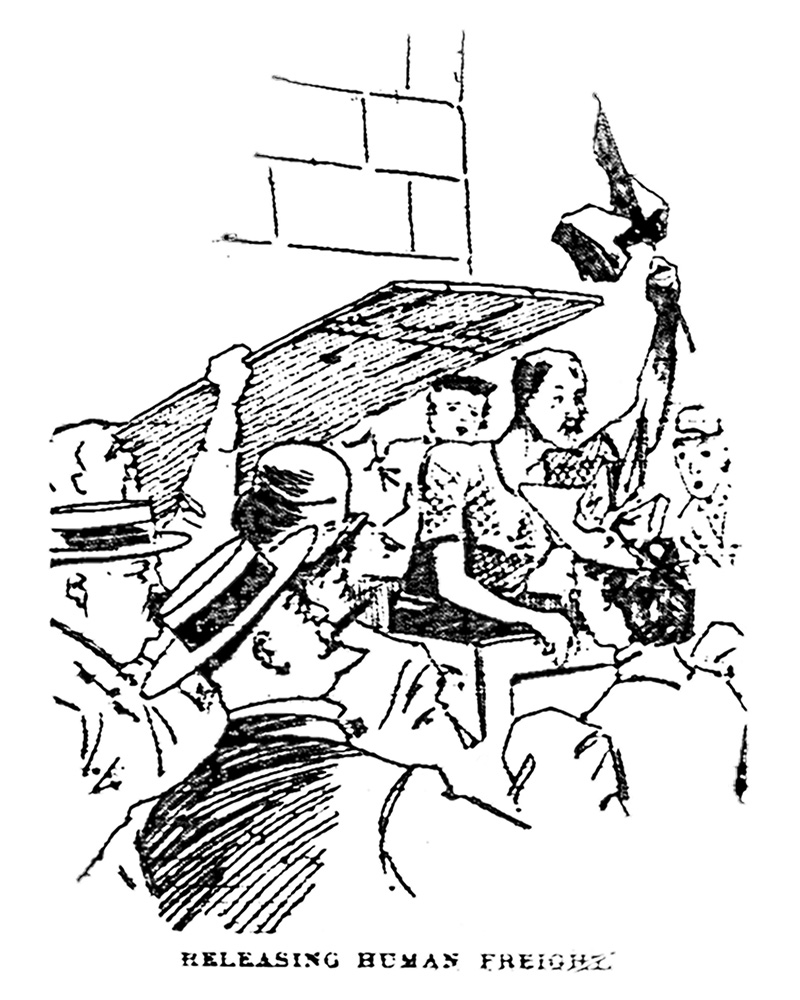
“Releasing Human Freight” from the box that arrived at the Austrian Village on the Midway. [Image from the Chicago Herald July 25, 1893.]
Disorderly conduct
No sooner had Ignatz fallen asleep than the Columbian Guard showed up and arrested him for having entered the fairgrounds without paying the fifty-cent admission fee. The American Express Company claimed that the rogue box rider had swindled them out of a passenger fare. They stated that there was a law preventing passengers from travelling by express, but Sergeant King of the Columbian Guard could find no such statute. To complicate matters, the train car that the young man had ridden in contained $500,000 in cash. If the express car manager had found the stowaway, he would have killed him as a suspected thief.
They took the tired Austrian to the Columbian Guard headquarters in the Services Building, but then sent the ill-looking youth to the emergency hospital. There, Dr. Yeager checked him out and pronounced him unharmed by the dangerous journey.
By late afternoon, the tired young man was taken away to the nearby Woodlawn Police Station, where another Austrian would be booked just days later. The justice system charged Ignatz Lefkovitz with simple “disorderly conduct,” but deemed his harrowing train trip reasonable punishment.
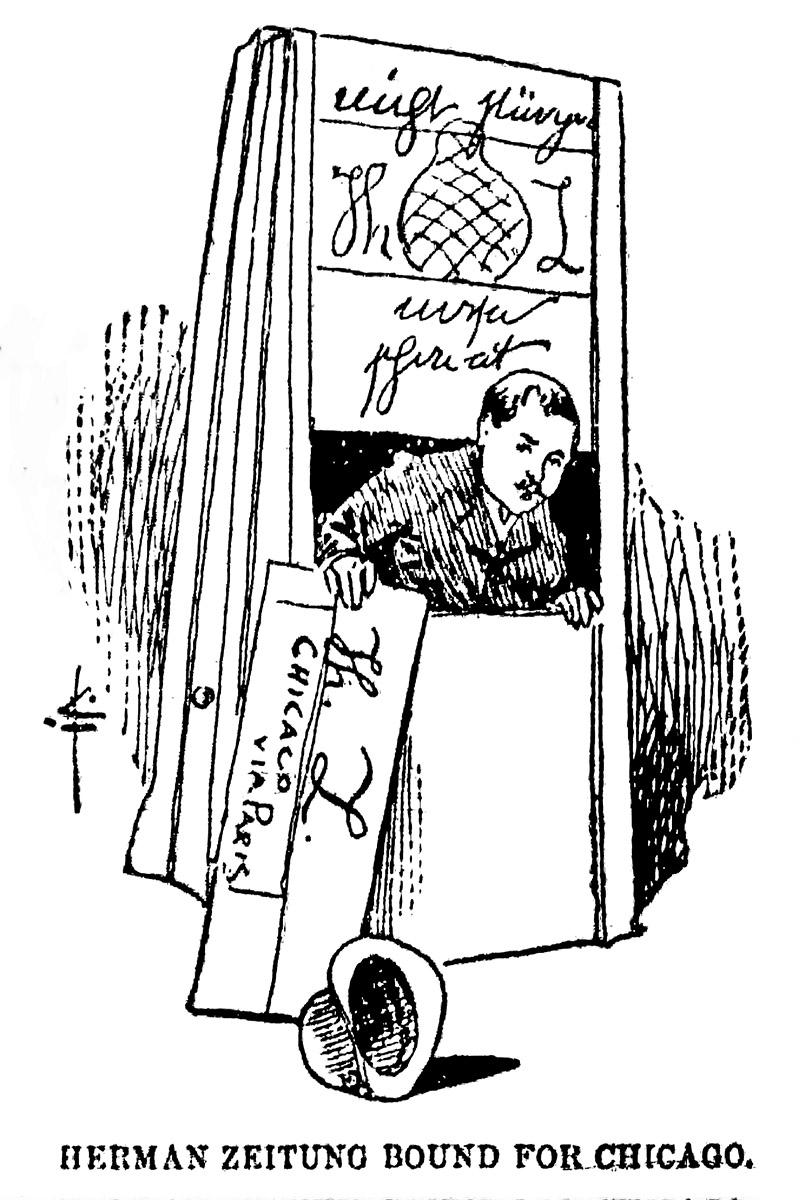
Fellow Austrian Herman Zeitung also mailed himself in box from New York to the World’s Fair in Chicago. [Image from the Fremont (NE) Daily Herald March, 8 1893.]
“I do not think I should try it again”
Several Austrian Villagers stood by him during the ordeal, and Mr. Braun hurried off to bail his countryman out of jail. Ignatz returned to Old Vienna for a good meal and regaled the Austrians with the full story of his journey to the World’s Fair. He needed a job, he told them, and could think of no better place to look for one than at the great fair in Chicago. Compassionate villagers took up a collection to help their countryman get on his feet.
“I got here all right and am going to stay now,” he told them. “I do not think I should try it again. Unlike his inspiration—who shipped himself around Europe and America for nearly a decade—Ignatz Lefkovitz seems to have made only this one trip in a box. His arrival at the Fair became “a peculiar sensation” on what was already one of the strangest streets in the world … until another human cargo box arrived on the Midway.
Just four days later, express mail agents delivered the seasoned boxer Herman Zeitung to the Chicago fairgrounds. It is hard to image that these two plucky Austrians did not meet each other on the Midway that summer. Perhaps they raised a glass of steinwein or gerspritzen to celebrate Austria Day together on August 18? Or maybe the two actually had met previously back in New York?
At least one news story reverses the credit for the shipping scheme, writing that Mr. Lefkovitz inaugurated the mode of cheap transport to the World’s Fair and was imitated by Mr. Zeitung! The press occasionally confused the two human cargo shipments, as when the Chicago Tribune in December 1893 described Mr. Zeitung as having been delivered to Old Vienna (reports at the time stated that he had been dropped off at Hagenbeck’s Animal Arena.) One international news report stated that Mr. Lefkovitz’s story “reads more like some of the impossible romances of Jules Verne.” Interestingly, it was Mr. Zeitung’s antics that Verne mentioned in one of his novels [see Part 1].
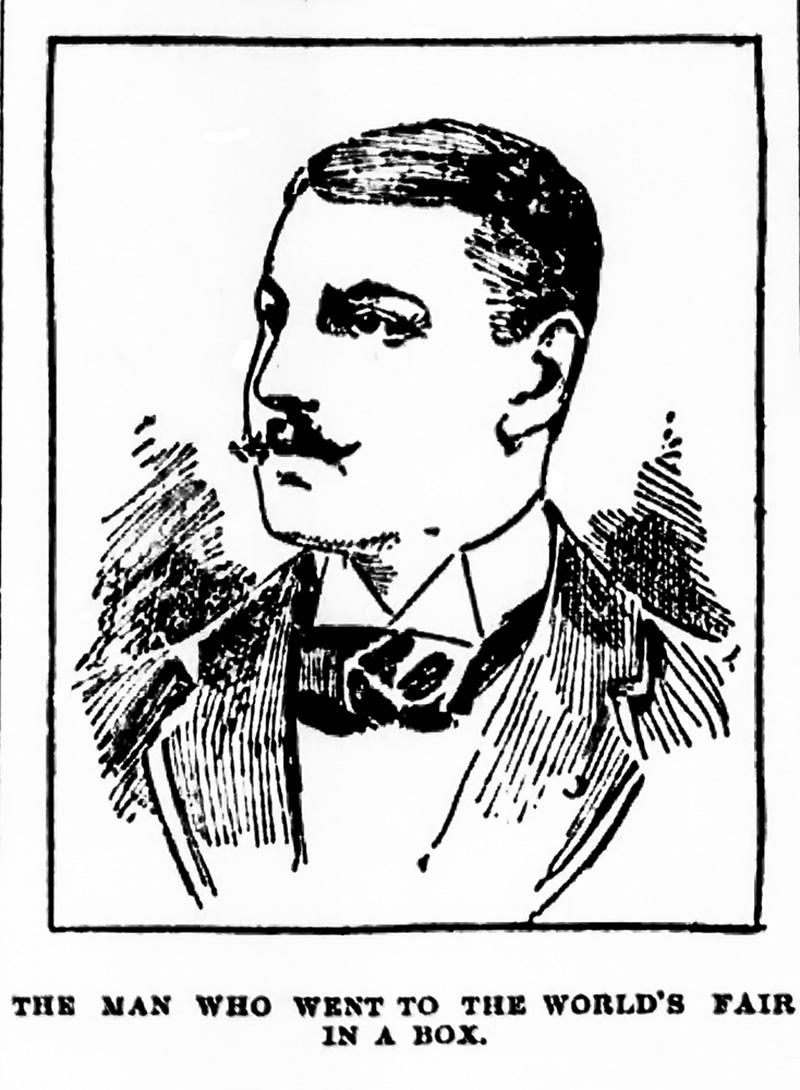
This portrait of “The Man Who Went to the World’s Fair in a Box” accompanied an article about Ignatz Lefkovitz, but depicts the other shipping box stowaway, Herman Zeitung. The press occasionally confused the two. [Image from the San Francisco Examiner Aug. 1, 1893.]
Human mail
The cases of Herman Zeitung and Ignatz Lefkovitz are among the earliest reported examples of “human mail.” Preceding them was Henry Box Brown, an enslaved African-American from Virginia who successfully escaped to freedom in 1849 by having himself mailed in a wooden crate to abolitionists in Philadelphia. One report about Ignatz’s trip in a box made the comparison to “Shoebox Miller” (real name James Ryan), who in 1881 had escaped from the Pennsylvania Western Penitentiary at Allegheny by hiding in a large box of shoes and being carried out undetected. The two Austrian self-mailers may be among the first people to choose this strange mode of transport simply for publicity or thrift. They made their trips to the 1893 World’s Fair years before the more well-known case of W. Reginald Bray mailing himself in England in 1900.
Among the tens of millions of visitors coming to see the great fair in Chicago, two Austrians arrived—just a bit battered and bruised—inside shipping boxes during one hot week in July. It’s easy to understand how their stories were lost in the annals of the Exposition. This chronicle aims to get their stories right side up.
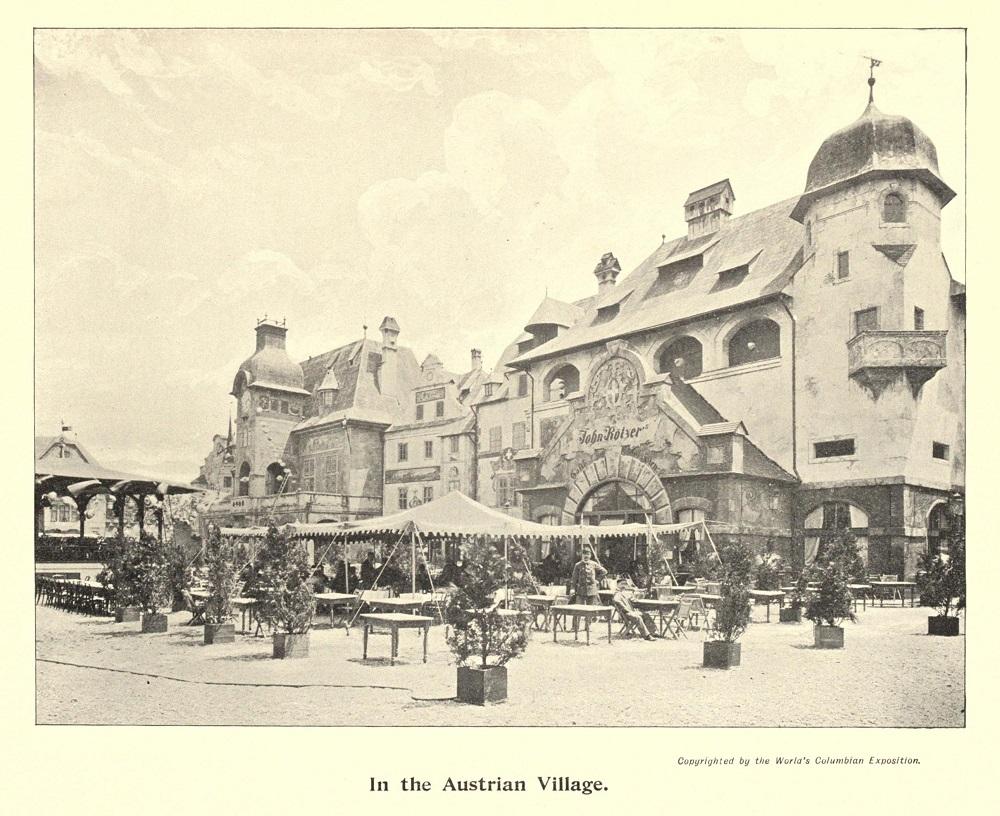
“In the Austrian Village” where Ignatz Lefkovitz arrived as human cargo. [Image from Shepp, James W.; Shepp, Daniel B. Shepp’s World’s Fair Photographed. Globe Bible Publishing, 1893.]
SOURCES
“Came in by Express” Chicago Record Jul. 25, 1893, p. 3.
“Cased Like a Corpse” Chicago Herald Jul. 25, 1893, p. 2.
“Charged Corpse Rate” Lexington (KY) Leader Aug. 3, 1893, p. 5.
“Fun at the Fair” New Orleans (LA) Times-Democrat Aug. 1, 1893, p. 10.
“He Traveled as Freight” San Francisco Examiner Aug. 1, 1893, p. 6.
“He Was a Viennese Boy” Wilmington (DE) Evening Journal Jul. 25, 1893, p. 1.
“He Yearns for Fame” Chicago Tribune Jul. 25, 1893, p. 1.
“Ignatz Got There” St. Joseph (MO) Daily News Jul. 25, 1893, p. 1.
“Man in Box Held for Trespass” Chicago Tribune Dec. 12, 1893, p. 4.
“A peculiar sensation …” Dublin (Ireland) Freeman’s Journal Aug. 9, 1893, p. 4.
“The remarkable …” Conneautville (PA) Courier Aug. 3, 1893, p. 1.
“To Chicago in a Box” Paterson (NJ) News Jul. 25, 1893, p. 6.
“Worked the Express Company” Omaha Daily Bee Jul. 29, 1893, p. 1.
“Zeitung’s Packing Case Trip” Chicago Tribune Jul. 29, 1893, p. 2.


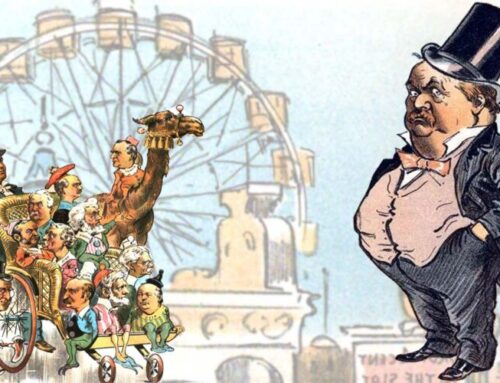
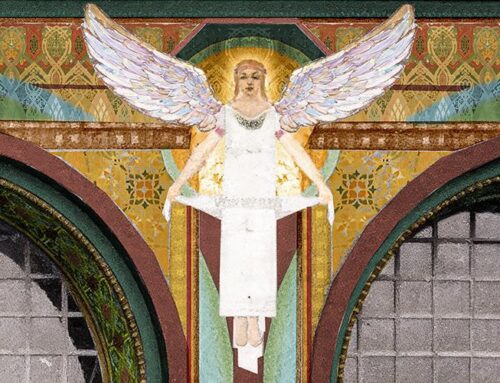
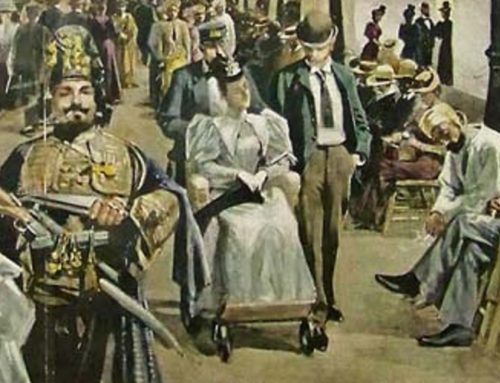

Is this the Ignatz Lefkovitz who went to the fair in a box? Born in 1868 and died in 1902, buried in Mount Zion Cemetery in Queens https://www.findagrave.com/memorial/26147233/ignatz-lefkovitz